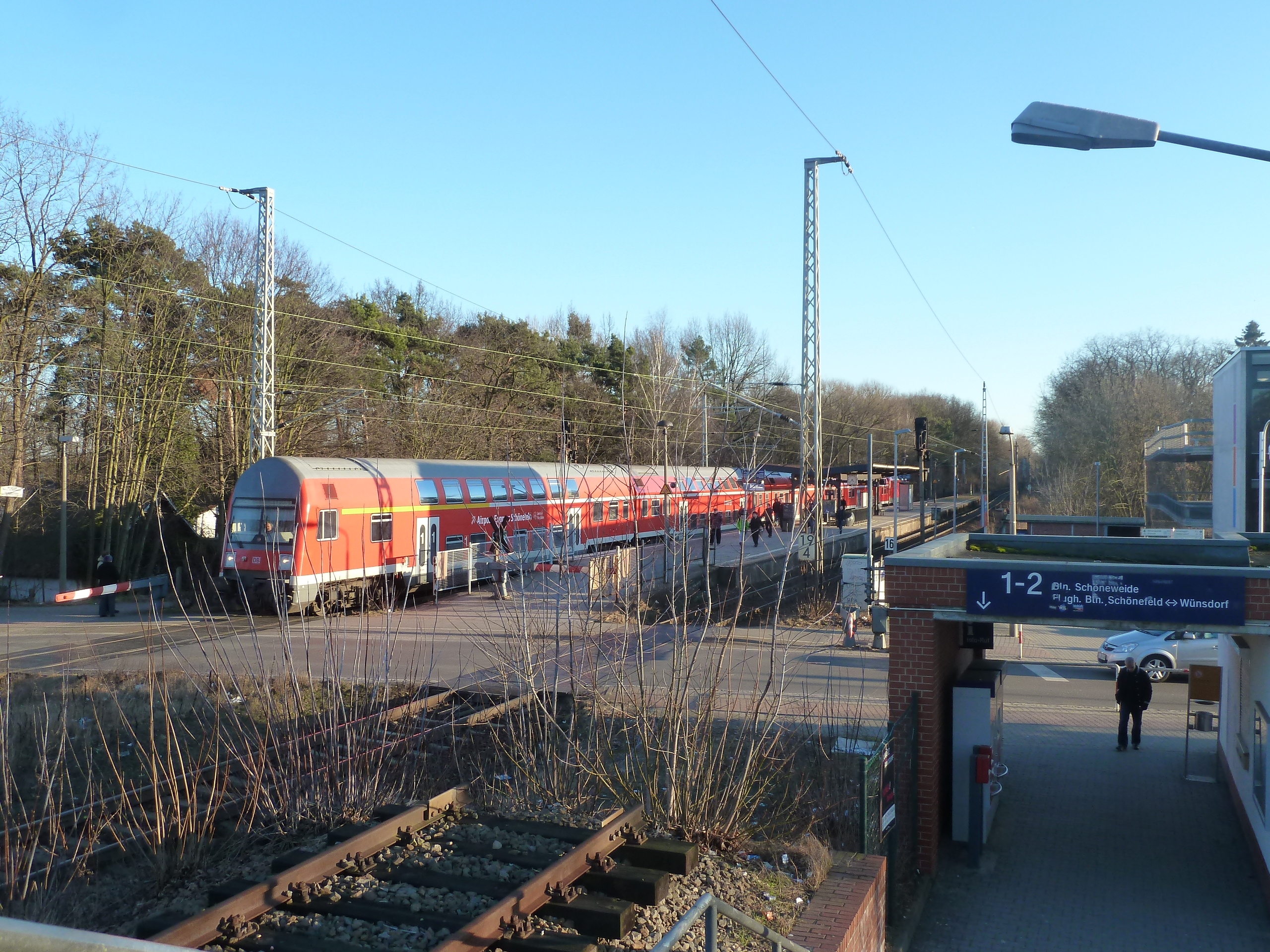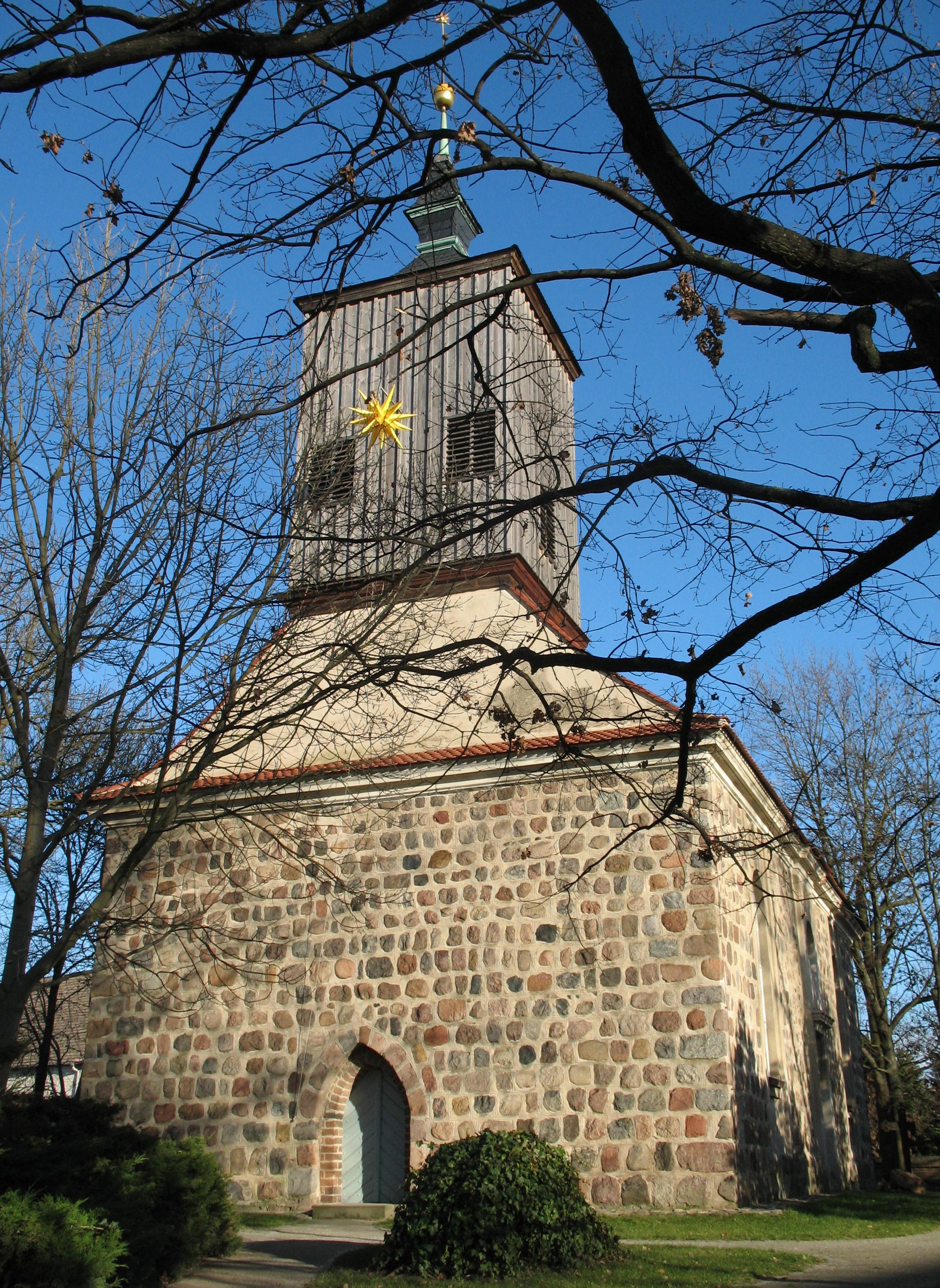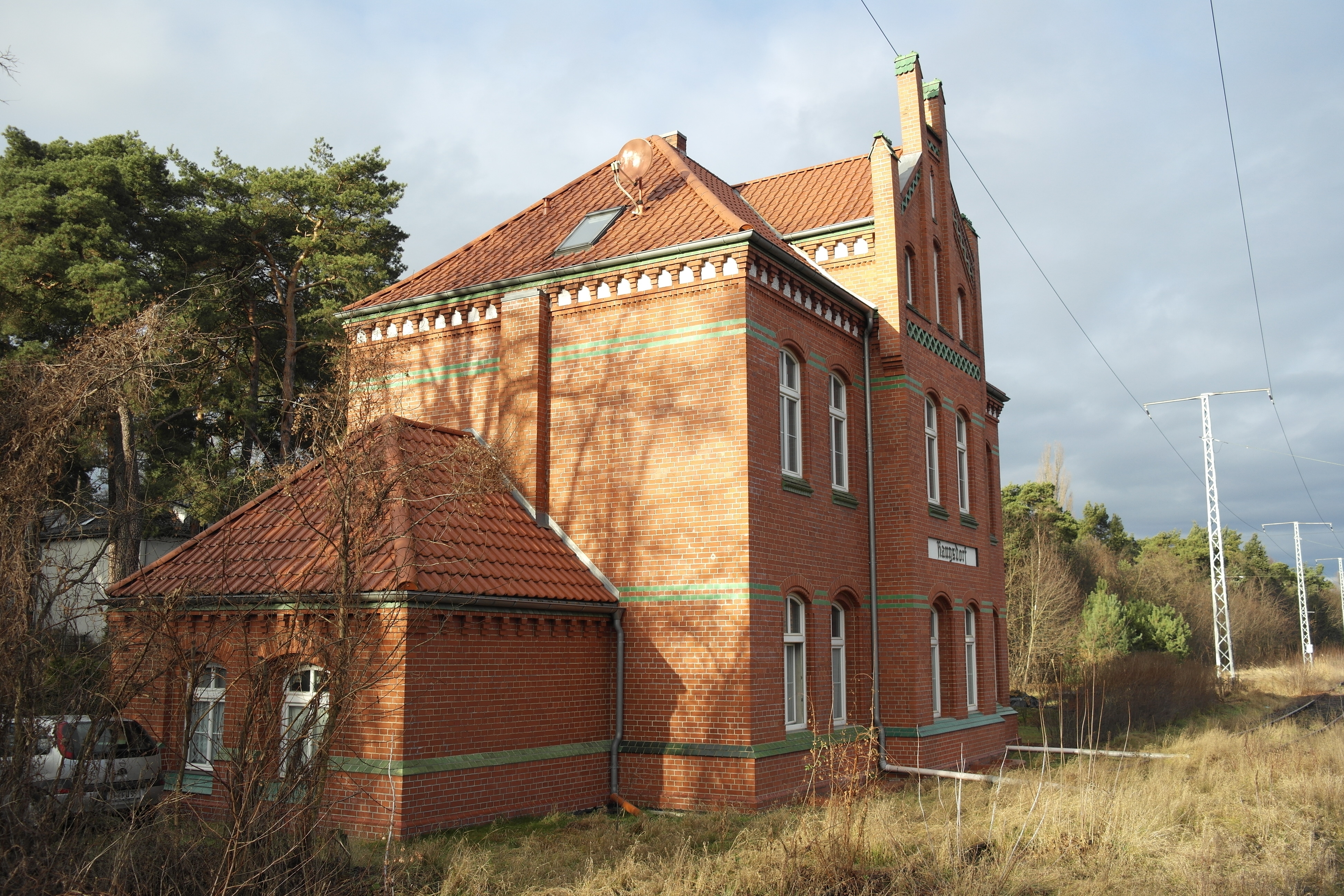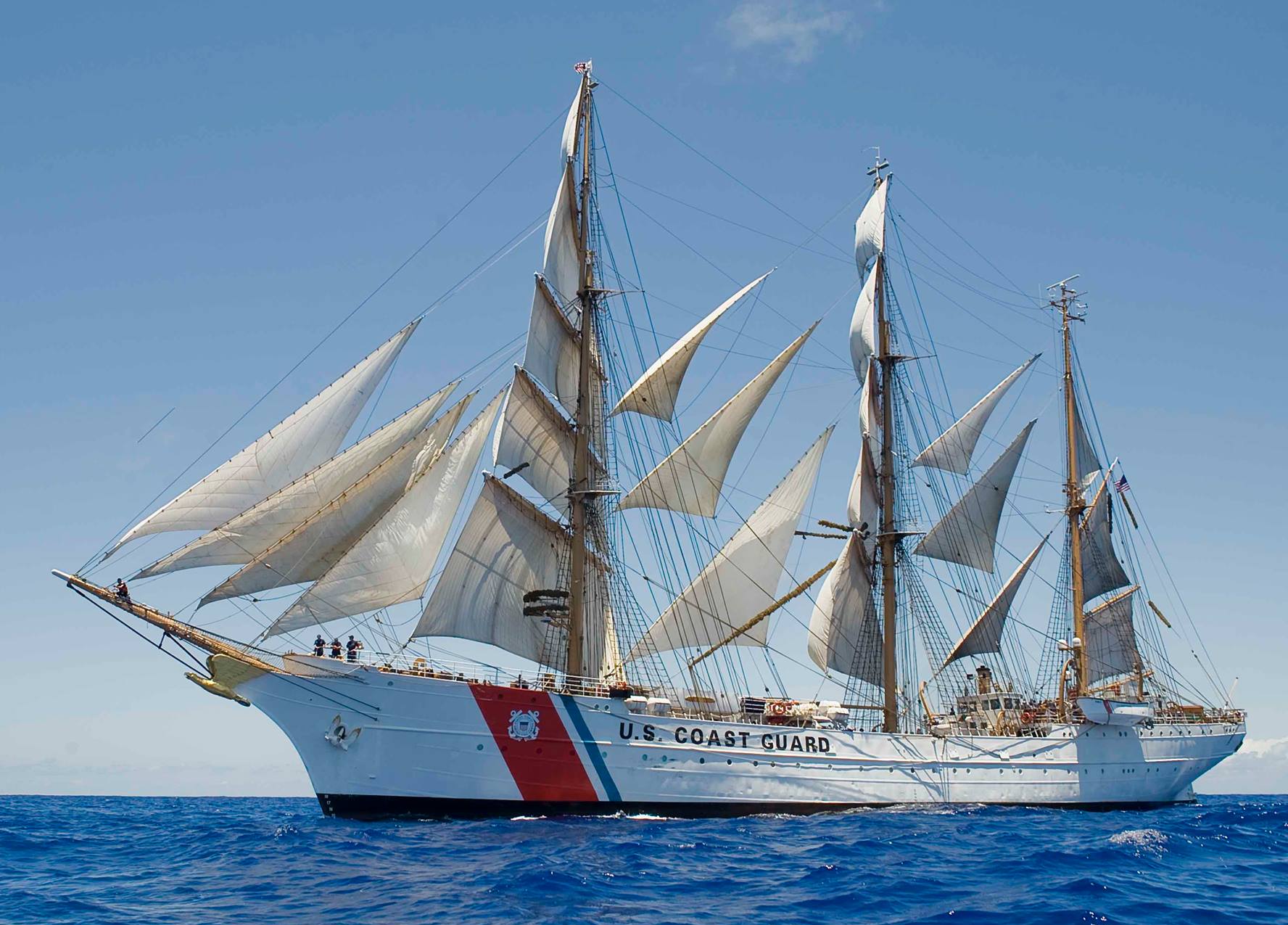|
Blankenfelde Station
Blankenfelde station is on the Berlin–Dresden railway in the locality of Blankenfelde in the municipality of Blankenfelde-Mahlow in the district of Teltow-Fläming in the German state of Brandenburg. The station consists of two sections that are structurally separate from each other. One section is located just south of the Karl-Marx-Straße level crossing and consists of an island platform for regional and long-distance services. The other section lies north of Karl-Marx-Straße and is the southern terminus of Berlin S-Bahn line S2. On the official S-Bahn maps its name is styled ''Blankenfelde (Kr. Teltow-Fläming)'' to avoid possible confusion with Blankenfelde locality in the Pankow district in northern Berlin. Location and infrastructure The station is situated in the locality of Blankenfelde at kilometre 19.4 of the Berlin–Dresden railway. Curves connect the long-distance tracks to the northern branch of Glasower Damm Süd junction on the Berlin Outer Ring (''Berliner Au ... [...More Info...] [...Related Items...] OR: [Wikipedia] [Google] [Baidu] |
Blankenfelde-Mahlow
Blankenfelde-Mahlow is a municipality in the Teltow-Fläming district of Brandenburg, Germany. It is situated approximately south of Berlin. History The municipality shared its borders with the former West Berlin, and so during the period 1961-1990 it was separated. Blankenfelde Blankenfelde was first mentioned in documents in 1375. However, a substantial part of this district, the so-called Gagfah settlement, did not develop until the 1930s, after the Süd-Berlin Bodenaktiengesellschaft had acquired and parceled out the area. As a result, the population increased significantly - from 766 inhabitants in 1930 to 6228 inhabitants in 1939. Mahlow Mahlow was first mentioned in documents in 1287. After the place had received a station in 1875, the immigration of wealthy Berliners. Its constituency is under Teltow from 1945 until its dissolution in 1952. As early as 1950, the community Glasow was merged with the community Mahlow. The construction of the Berlin Wall from 13 August ... [...More Info...] [...Related Items...] OR: [Wikipedia] [Google] [Baidu] |
Berlin Outer Ring
The Berlin outer ring (german: Berliner Außenring, BAR) is a long double track electrified railway, originally built by the German Democratic Republic to bypass West Berlin in preparation for the building of the Berlin Wall during the division of Germany. It was developed by East Germany for economic, transport policy, and military reasons between 1951 and 1961 and included parts of some older lines (Outer Freight Ring, Jüterbog–Nauen railway, and Michendorf–Großbeeren railway). Without the completion of the outer ring it would not have been possible to build the Berlin Wall, sealing off West Berlin, without disrupting East Germany’s transport links. The Potsdam-Schönefeld Expressway was built for similar reasons. The term ''Outer ring'' is used to distinguish the line from the Ring line of inner Berlin. Route Starting at the Anhalt line in the south, the outer ring runs from Genshagener Heide to Schönefeld Airport, Grünau Cross, Wuhlheide, Schönfließ, Go ... [...More Info...] [...Related Items...] OR: [Wikipedia] [Google] [Baidu] |
Control Car (rail)
A control car, cab car (North America), control trailer, or driving trailer (UK and Ireland) is a non-powered rail vehicle from which a train can be operated. As dedicated vehicles or regular passenger cars, they have one or two driver compartments with all the controls and gauges required to remotely operate the locomotive, including exterior locomotive equipment such as horns, bells, ploughs, and lights. They also have communications and safety systems such as GSM-R or European Train Control System (ETCS). Control cars enable push-pull operation when located on the end of a train opposite its locomotive by allowing the train to reverse direction at a terminus without moving the locomotive or turning the train around. Control cars can carry passengers, baggage, and mail, and may, when used together with diesel locomotives, contain an engine-generator set to provide head-end power (HEP). They can also be used with a power car or a railcar. European railways have used control c ... [...More Info...] [...Related Items...] OR: [Wikipedia] [Google] [Baidu] |
Berlin Schönefeld Flughafen Station
Berlin ( , ) is the capital and largest city of Germany by both area and population. Its 3.7 million inhabitants make it the European Union's most populous city, according to population within city limits. One of Germany's sixteen constituent states, Berlin is surrounded by the State of Brandenburg and contiguous with Potsdam, Brandenburg's capital. Berlin's urban area, which has a population of around 4.5 million, is the second most populous urban area in Germany after the Ruhr. The Berlin-Brandenburg capital region has around 6.2 million inhabitants and is Germany's third-largest metropolitan region after the Rhine-Ruhr and Rhine-Main regions. Berlin straddles the banks of the Spree, which flows into the Havel (a tributary of the Elbe) in the western borough of Spandau. Among the city's main topographical features are the many lakes in the western and southeastern boroughs formed by the Spree, Havel and Dahme, the largest of which is Lake Müggelsee. Due to its location ... [...More Info...] [...Related Items...] OR: [Wikipedia] [Google] [Baidu] |
Wünsdorf-Waldstadt Station
Wünsdorf-Waldstadt (german: Bahnhof Wünsdorf-Waldstadt) is a railway station in the town of Wünsdorf, Brandenburg, Germany, on the Berlin–Dresden railway, with services operated by Deutsche Bahn The (; abbreviated as DB or DB AG) is the national railway company of Germany. Headquartered in the Bahntower in Berlin, it is a joint-stock company ( AG). The Federal Republic of Germany is its single shareholder. describes itself as the se .... Train services The station is served by the following services: *Regional services ''Rostock / Stralsund – Neustrelitz – Berlin – Wünsdorf-Waldstadt – Elsterwerda'' *Regional ser ... [...More Info...] [...Related Items...] OR: [Wikipedia] [Google] [Baidu] |
Berlin Wall
The Berlin Wall (german: Berliner Mauer, ) was a guarded concrete barrier that encircled West Berlin from 1961 to 1989, separating it from East Berlin and East Germany (GDR). Construction of the Berlin Wall was commenced by the government of the GDR on 13 August 1961. It included guard towers placed along large concrete walls, accompanied by a wide area (later known as the "death strip") that contained anti-vehicle trenches, beds of nails and other defenses. The Eastern Bloc portrayed the Wall as protecting its population from fascist elements conspiring to prevent the "will of the people" from building a socialist state in the GDR. The authorities officially referred to the Berlin Wall as the ''Anti-Fascist Protection Rampart'' (german: Antifaschistischer Schutzwall, ). The West Berlin city government sometimes referred to it as the "Wall of Shame", a term coined by mayor Willy Brandt in reference to the Wall's restriction on freedom of movement. Along with the separat ... [...More Info...] [...Related Items...] OR: [Wikipedia] [Google] [Baidu] |
Rangsdorf Railway Station
Rangsdorf station is a station in the locality of Rangsdorf in the district of Teltow-Fläming in the German state of Brandenburg. It is located at kilometre 24.3 of Berlin–Dresden railway. Until 1919, the western part of the station was served by the Royal Prussian Military Railway. Location and infrastructure The station is located in Fontaneplatz to the west of the centre of the village of Rangsdorf. It is at ground level and consists of three platforms for passenger traffic. The entrance building of the former Military Railway is located to the west of the tracks and is now used as a residential building. The entrance building of the former Berlin-Dresden railway is located on the eastern side. A third entrance was built at the southern end during the development of the former Military Railway platform for suburban traffic in 1940. A footbridge connects the platforms and both sides of the station. The military station, which was later developed as a suburban station is list ... [...More Info...] [...Related Items...] OR: [Wikipedia] [Google] [Baidu] |
Soviet Union
The Soviet Union,. officially the Union of Soviet Socialist Republics. (USSR),. was a transcontinental country that spanned much of Eurasia from 1922 to 1991. A flagship communist state, it was nominally a federal union of fifteen national republics; in practice, both its government and its economy were highly centralized until its final years. It was a one-party state governed by the Communist Party of the Soviet Union, with the city of Moscow serving as its capital as well as that of its largest and most populous republic: the Russian SFSR. Other major cities included Leningrad (Russian SFSR), Kiev (Ukrainian SSR), Minsk ( Byelorussian SSR), Tashkent (Uzbek SSR), Alma-Ata (Kazakh SSR), and Novosibirsk (Russian SFSR). It was the largest country in the world, covering over and spanning eleven time zones. The country's roots lay in the October Revolution of 1917, when the Bolsheviks, under the leadership of Vladimir Lenin, overthrew the Russian Provisional Government ... [...More Info...] [...Related Items...] OR: [Wikipedia] [Google] [Baidu] |
War Reparations
War reparations are compensation payments made after a war by one side to the other. They are intended to cover damage or injury inflicted during a war. History Making one party pay a war indemnity is a common practice with a long history. Rome imposed large indemnities on Carthage after the First (Treaty of Lutatius) and Second Punic Wars. Some war reparations induced changes in monetary policy. For example, the French payment following the Franco-Prussian war played a major role in Germany's decision to adopt the gold standard; the 230 million silver taels in reparations imposed on defeated China after the First Sino-Japanese War led Japan to a similar decision. There have been attempts to codify reparations both in the Statutes of the International Criminal Court and the UN Basic Principles on the Right to a Remedy and Reparation for Victims, and some scholars have argued that individuals should have a right to seek compensation for wrongs they sustained during warfare ... [...More Info...] [...Related Items...] OR: [Wikipedia] [Google] [Baidu] |
East Berlin
East Berlin was the ''de facto'' capital city of East Germany from 1949 to 1990. Formally, it was the Allied occupation zones in Germany, Soviet sector of Berlin, established in 1945. The American, British, and French sectors were known as West Berlin. From 13 August 1961 until 9 November 1989, East Berlin was separated from West Berlin by the Berlin Wall. The Western Allied powers did not recognize East Berlin as the GDR's capital, nor the GDR's authority to govern East Berlin. On 3 October 1990, the day Germany was officially German reunification, reunified, East and West Berlin formally reunited as the city of Berlin. Overview With the London Protocol (1944), London Protocol of 1944 signed on 12 September 1944, the United States, the United Kingdom, and the Soviet Union decided to divide Germany into three occupation zones and to establish a special area of Berlin, which was occupied by the three Allied Forces together. In May 1945, the Soviet Union installed a city gove ... [...More Info...] [...Related Items...] OR: [Wikipedia] [Google] [Baidu] |
Berlin Anhalter Bahnhof
The Anhalter Bahnhof is a former railway terminus in Berlin, Germany, approximately southeast of Potsdamer Platz. Once one of Berlin's most important railway stations, it was severely damaged in World War II, and finally closed for traffic in 1952, when the GDR-owned ''Deutsche Reichsbahn'' rerouted all railway traffic between Berlin and places in the GDR avoiding the West Berlin area. The station's name lives on in the Berlin S-Bahn station of the same name, opened in October 1939 as part of the ''North-South S-Bahn link''. Construction Work to build the Anhalter Bahnhof began on 15 April 1839. As the Berlin terminus, of what become known as the Anhalt Railway, it opened on 1 July 1841 as far as Jüterbog (the inaugural train being hauled by the very first Borsig locomotive), and extended to Dessau, Köthen and beyond at later dates. It became known as the "Anhalt line" because it ran through the historical state of Anhalt, which in turn gave the new Berlin terminus its na ... [...More Info...] [...Related Items...] OR: [Wikipedia] [Google] [Baidu] |
Districts Of Germany
In all German states, except for the three city states, the primary administrative subdivision higher than a '' Gemeinde'' (municipality) is the (official term in all but two states) or (official term in the states of North Rhine-Westphalia and Schleswig-Holstein). Most major cities in Germany are not part of any ''Kreis'', but instead combine the functions of a municipality and a ''Kreis''; such a city is referred to as a (literally "district-free city"; official term in all but one state) or (literally "urban district"; official term in Baden-Württemberg). ''(Land-)Kreise'' stand at an intermediate level of administration between each German state (, plural ) and the municipal governments (, plural ) within it. These correspond to level-3 administrative units in the Nomenclature of Territorial Units for Statistics (NUTS 3). Previously, the similar title ( Imperial Circle) referred to groups of states in the Holy Roman Empire. The related term was used for similar a ... [...More Info...] [...Related Items...] OR: [Wikipedia] [Google] [Baidu] |








